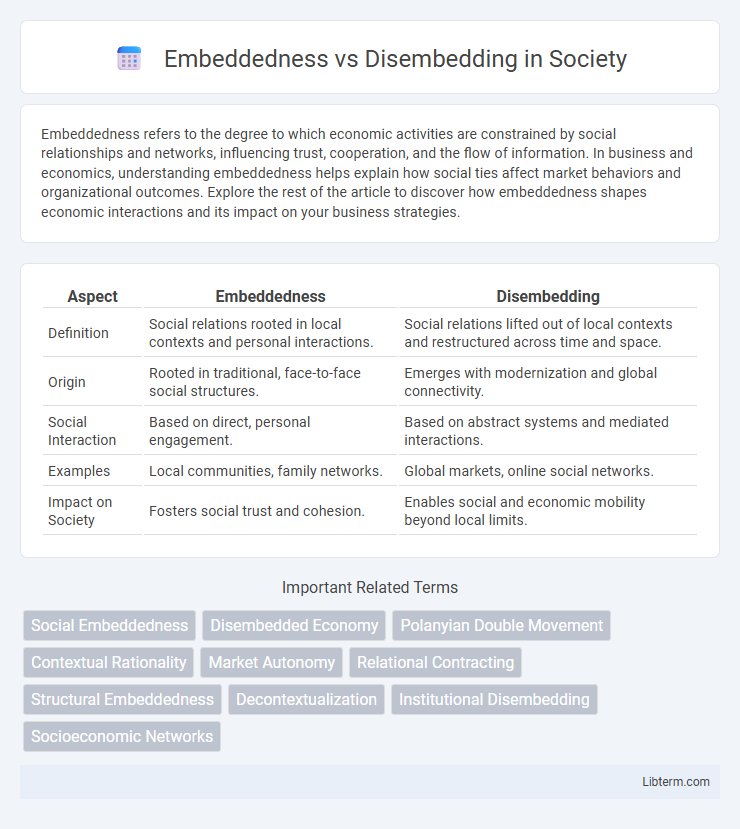Embeddedness refers to the degree to which economic activities are constrained by social relationships and networks, influencing trust, cooperation, and the flow of information. In business and economics, understanding embeddedness helps explain how social ties affect market behaviors and organizational outcomes. Explore the rest of the article to discover how embeddedness shapes economic interactions and its impact on your business strategies.
Table of Comparison
| Aspect | Embeddedness | Disembedding |
|---|---|---|
| Definition | Social relations rooted in local contexts and personal interactions. | Social relations lifted out of local contexts and restructured across time and space. |
| Origin | Rooted in traditional, face-to-face social structures. | Emerges with modernization and global connectivity. |
| Social Interaction | Based on direct, personal engagement. | Based on abstract systems and mediated interactions. |
| Examples | Local communities, family networks. | Global markets, online social networks. |
| Impact on Society | Fosters social trust and cohesion. | Enables social and economic mobility beyond local limits. |
Understanding Embeddedness: Definition and Context
Embeddedness refers to the degree to which economic activities, social relations, and individual behaviors are intertwined with and influenced by the broader social, cultural, and institutional contexts. Understanding embeddedness involves recognizing how economic actions are not autonomous but are shaped by networks of trust, norms, and shared values within communities or societies. This concept highlights the importance of social structures and institutional frameworks in shaping market dynamics and individual decision-making processes.
The Concept of Disembedding in Modern Society
Disembedding in modern society refers to the process where social relations are lifted out of localized contexts and restructured across indefinite time-space dimensions, facilitated by mechanisms such as money and expert systems. This concept highlights how personal interactions and societal functions become abstracted from direct, face-to-face encounters, leading to increased dependence on institutional frameworks and technological mediation. As a result, individuals navigate complex social networks detached from traditional social ties, transforming the nature of community and social cohesion.
Historical Evolution: From Embeddedness to Disembedding
The historical evolution from embeddedness to disembedding marks a shift from tightly interwoven social and economic relationships to more abstract, impersonal systems driven by market forces and bureaucratic institutions. Classic sociologist Karl Polanyi emphasized how pre-modern economies were embedded in social norms, while modern industrial societies experience disembedding through mechanisms like money and credit that operate independently of social ties. This transition reflects broader changes in social structures, technological advancements, and globalization, reshaping interactions and economic organization across historical periods.
Key Theorists: Polanyi, Giddens, and Beyond
Embeddedness, a concept central to Karl Polanyi, emphasizes how economic activities are constrained by social relationships and cultural norms, contrasting sharply with disembedding, which refers to the separation of economic processes from traditional social contexts. Anthony Giddens extends this framework through the theory of structuration, highlighting the dynamic interplay between agency and structure where social systems become increasingly disembedded due to the rise of modern institutions and reflexive monitoring. Contemporary theorists build on these ideas by exploring how digital technologies and globalization further intensify disembedding, reshaping social interactions and economic exchanges in a rapidly evolving networked society.
Social Structures: How Embeddedness Shapes Communities
Embeddedness refers to the degree to which social relationships and networks are intertwined within a community, fostering trust, cooperation, and shared norms that strengthen social structures. Disembedding occurs when social interactions are lifted out of local contexts, often through formal institutions or technology, weakening traditional ties and altering community cohesion. Social structures deeply embedded in local interactions facilitate collective identity and resilience, whereas disembedding can lead to more fragmented and impersonal communities.
Disembedding Forces in Globalization and Technology
Disembedding forces in globalization and technology disrupt traditional social and economic structures by detaching relationships and interactions from local contexts, enabling global networks and digital platforms to transcend geographic boundaries. Technological advancements like the internet, blockchain, and AI facilitate real-time communication, decentralized transactions, and virtual collaboration, reducing the relevance of physical proximity in economic and social exchanges. These forces accelerate globalization by fostering interconnectedness and redefining cultural, economic, and political activities on a global scale.
Economic Impacts: Markets, Institutions, and Social Relations
Embeddedness describes how economic activities are deeply rooted in social relations and institutions, shaping market behaviors through trust and shared norms. Disembedding involves the separation of economic systems from social contexts, leading to more impersonal, market-driven transactions influenced by standardized regulations and contractual frameworks. This shift affects economic outcomes by transforming markets into autonomous entities, reducing reliance on local social networks, and fostering globalization and institutional reforms.
Cultural Consequences: Identity, Belonging, and Alienation
Embeddedness fosters strong cultural identity and belonging by anchoring individuals within familiar social networks and traditions, reinforcing shared values and collective memory. Disembedding, characterized by the loosening of social ties from local contexts, often leads to feelings of alienation and identity fragmentation as individuals navigate globalized or mediated environments. This shift impacts cultural continuity and challenges the cohesion of communities, prompting individuals to renegotiate their sense of self and belonging in increasingly fluid social landscapes.
Challenges of Re-Embedding in a Rapidly Changing World
Re-embedding in a rapidly changing world faces challenges such as economic volatility, cultural fragmentation, and technological disruptions that weaken social networks and trust. Globalization and digital transformation often disembed local communities from traditional institutions, complicating efforts to rebuild cohesive social and economic ties. Effective re-embedding requires adaptive governance, inclusive policies, and resilient community frameworks to restore stability and meaning in decentralized environments.
Future Perspectives: Balancing Embeddedness and Disembedding
Future perspectives on balancing embeddedness and disembedding highlight the need for adaptive frameworks that integrate local cultural values with global technological advancements. Emphasizing hybrid models, organizations and societies can harness embedded social networks while leveraging disembedded systems to foster innovation and resilience. Such balance promotes sustainable development by aligning economic activities with community identities and digital globalization trends.
Embeddedness Infographic

 libterm.com
libterm.com